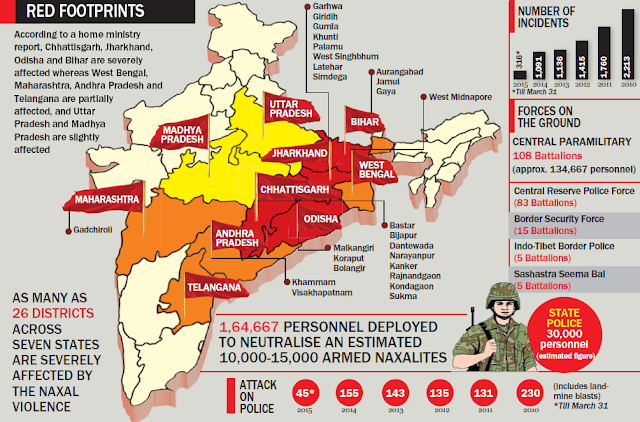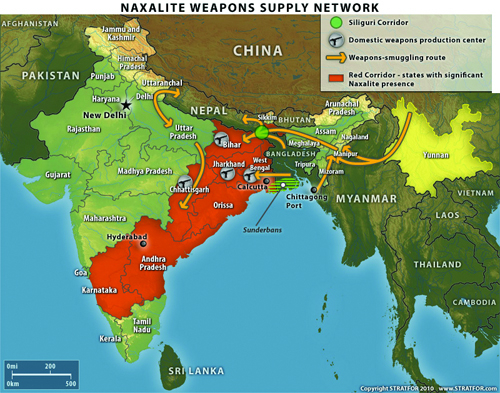India, being one of the fastest growing economies in the world, has great potential to become a superpower. However, it faces a severe threat in its path – Naxalism.
In India before Independence due to the caste system, the landlord upper caste people owned cultivable lands across the nation and landless farmers were driving for the living into the forest. Even the British did not interfere with it because of the complex system, and this continued until Independence.
Following Independence when the constituent assembly was formed to frame India's constitution, our leaders formed two articles to address this issue- Fifth and Ninth Schedule.
5th Schedule:
The country's planned areas inhabited by the tribes and forest reserves are to be managed by the state's governor who would form a tribal council from among the tribes. Regrettably, this council was not formed in any state and state government by leasing the land to mining and private companies to create a vacuum.
9th Schedule:
Acquisition by the government of cultivable land owned by the upper caste landlords for over thousands of years and redistribution to landless farmers. Only three states -Jammu and Kashmir, West Bengal and Kerala-have been implemented this procedure in India.
Rules were implemented during the Communist rule in Kerala and West Bengal. This law has been quite successful in Kerala and has therefore prevented a revolution. Jotedars-Landlords in West Bengal tried to manipulate the land records and tricked the farmers. This led to the Naxalbhari village uprising.
‘Naxalism’, thus the word, has been derived from the name – ‘Naxalbari’, a village in West Bengal, where the movement in originated. Their origin can be witnessed from the split of the communist party of India. They are followers of the Leninist – Marxist Theory. Inspired by the doctrine of Mao Zedong, Naxalites are to overthrow the government and upper classes by violence.
Because of the lack of successful implementation of the Constitution's Fifth and Ninth schedule, the ground was created for the formation of the Communist Party of India-ML (Marxist-Leninist) who were commonly called Naxals because of their origin.
From West Bengal, these moves spread to various areas of Chhattisgarh, Jharkhand, Odisha and Andhra Pradesh. Presently, they are active in approximately 40% of India’s Geographical area. They control large portions of remote and densely forested area and are concentrated in an area called Red Corridor.

Causes of Spread of Naxalism
Culture
Tribals have a different culture from us. They are very close to native – forest, land and river. They have their way of social behaviour, lifestyle and culture. Tribals sense that outsiders are a threat to their culture and can mutate their way of life.
Forest policy
Tribals have a distinct way of carrying out activities like agriculture. They practice slash and burn type, which leads to deforestation and reduces soil fertility. The forest policy prohibits them from deforesting an area of land which they regard as an interference in their matters.
Read here about One Nation, One Election
Governance
Sometimes people think that they are deprived of government policies and are not part of the decision-making process. That also leads to the spread of the cause.
Ethnic Clashes with other tribes
As the clash between NSCN (Nationalist Socialist Council of Nagaland) Nagas and Manipuri Meiteis, there are many ethnic clashes have been going on amongst the tribal communities, which sometimes lead to the destruction of government property and affects the tribal people.
Fight Between Ideologies
Naxal’s point of view
The tribal communities make about 8.4% of the population and live in severe poverty. They live in a remote area and are socio-economically backwards. The lack of proper representation, rampant corruption and diverted funds for tribal have created an ideology that the government has neglected them. They feel like they need the power to make themselves known and get their demands fulfilled. That is why they engage in these activities.
Government point of view
Continuous failure of confidence-building measures and corruption in providing the tribal people with a good standard of living is the problem that the government is dealing with. Efforts are made to increase infrastructure but at the same time, same time frequent delays to armed conflicts with Naxals have decreased the pace of development.
Moreover, countries like China and Pakistan have hijacked the Naxal movement and provided them with finances, arms and training spread unrest and destroy the peace of the nations.

Effects of Naxalism
- Lower exports, reduced bilateral trade flows and reduced foreign direct investment inflows. – Due to the Naxal violence and their extortion business foreign and domestic investment remains low. These problems are coupled with the lack of good transportation facilities which are also a victim of Naxal violence.
- Higher expenditure on defence at the cost of lower expenditure on education and health.
- Adverse effects on the trade and economy such as damage to road construction machinery, shutting down and destroying bank branches, damage to railway lines, highways and telecom towers thereby inhibiting communication and transport and destruction of life & property.
- Extreme Poverty & negative development of the particular state suffering from Naxalism.
- The common man is perishing in between the tussle of Naxals & the government.
- The Youth of the country is being derailed and brainwashed to join such an organisation.
Blueprint to Ending Naxalism in India
A three-step approach should be adopted by the government to curb Naxalism:
Co-ordination between police and intelligence agencies to stop the funding of Naxals from various routes. Forming an Austrian-like "extremism counselling hotline" – allowing "vulnerable and indoctrinated" youth parents, teachers and friends to seek professional help for their "deradicalization".
Paramilitary and state police working in unison to combat the Naxalites by conducting counter-insurgency operations
More focus on developing confidence-building measures in the tribal areas, such as providing them with adequate representation, making them economically independent, making them feel as one. Also, utmost regard to social welfare, health and rural development should be taken.
Initiatives of Government: Operation Samadhan
Aggressive strategy – More operational assistance by helicopters + 400 fortified police stations.
Technology harnessing – UAVs and Maoist hotbed drones + GPS tracking + satellite pictures.
Training and motivation – training forces to take on Naxals with state of the art equipment.

Post a Comment